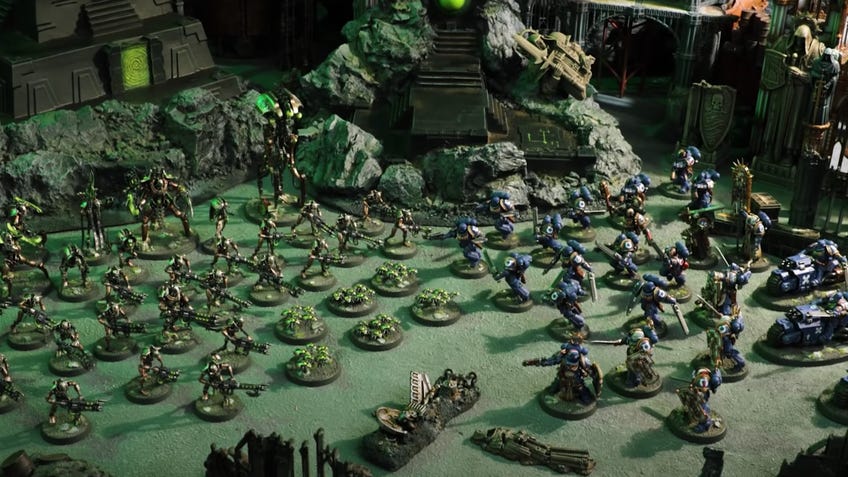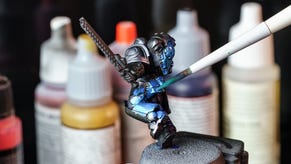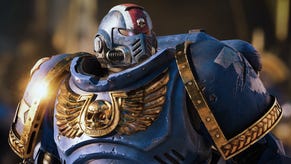Warhammer 40,000: Indomitus review - first Ninth Edition box set mostly hits the mark as an entry point for 40k first-timers
Silencers of C’tan.
First things first - the ninth edition of Warhammer 40,000 marks my first foray into 40k. While I'm an avid player of Age of Sigmar and Warcry, I’d never tackled Games Workshop’s futuristic behemoth before getting my hands on Indomitus, the game’s latest boxed release that marks the official launch of Ninth Edition.
As such, if you’re looking for a forensic breakdown of all the rules changes for this new edition and how they stack up compared to previous iterations, this ain’t it. What I can bring you, however, is a fresh perspective on the contents of Indomitus, how the game plays and whether it’s worth purchasing for existing players and those ready to make their first steps into that grim, dark future.
Indomitus is a pretty hefty set. A lot of that is down to the generous amount of plastic, to which I’ll return shortly, but much of the weight is down to the whacking great core rulebook. While its sheer size may seem daunting at first, it’s an excellent starting point for anybody new to 40k. Previously I found the lore impenetrable due to there A) being so much of it and B) everyone’s opinions being so unfeasibly strong. I knew the Horus Heresy was a big deal, and that people really seem to enjoy making fun of Space Wolves, but I never really understood why.
Ninth Edition's rulebook is an excellent starting point for anybody new to 40k.
It took 192 pages of lore to get there, but I now feel pretty well versed in Warhammer 40,000 and the various factions that wage eternal war for or against the Emperor. Better yet, it didn’t feel like a chore; the core book is well written and beautifully laid out, making it a lovely volume to get to grips with. As well explaining the current state of the Imperium of Man, the set focuses on a few key battlegrounds - including the Pariah Nexus and its part in the titular Indomitus Crusade. These focal points help set the scene for any narrative campaign, regardless of the factions involved, but also go a long way to providing context for the Angels of Death and Necron forces included in Indomitus.
While the core book delights in telling its own tale, the rules section, by contrast, is gratifyingly brief. 40k drew a lot of inspiration from Age of Sigmar for its eighth (and therefore ninth) edition and that shared DNA doubtless made it easier for me to learn the basics. All the same, I found the rules to be pleasingly direct, but also comprehensive. Existing players will take no time at all getting up to speed on how things work for this new edition, while absolute newcomers are guided through each of the game’s phases, learning not just what happens but why.

Putting that book learning into practice, I found 40k’s ninth edition to be a smooth-running game that’s surprisingly swift. While things inevitably slow down once entire squads bring their bolt throwers to bear and the fistfuls of dice start flying, I was impressed by how soon the action actually gets going. Because Age of Sigmar tends to have comparatively little ranged weaponry, it’s common for the start of any battle to feel like one long manoeuvre as players inch their forces toward the inevitable melee somewhere in the middle.
40k’s ninth edition is a smooth-running game that’s surprisingly swift.
With ranged weaponry playing such a crucial role in Warhammer 40,000, however, it felt like my units were playing an important role from the get-go. Each unit’s range of influence over the battlefield is fairly large, and that is very satisfying - I could commit units to an objective point knowing that they could still provide valuable support to the rest of my forces, rather than picking a flank and hoping not to be routed before help could be sent over.
Thanks to social distancing guidelines during the COVID-19 pandemic, I ended up playing outside on an extremely blustery day which was, in no uncertain terms, a nightmare. While we regularly had to pause to construct wind breaks and fish the occasional Necron out of a plant pot, we nonetheless had a great time - it’s easy to see why the appeal of 40k has endured for so long and, at least to a relative newcomer, it seems to be on fine form in this new edition.
As far as plastic goes, Indomitus is a pretty generous box. There are 61 models in all: 24 Space Marines and 37 Necrons. While the armies from dual-focus boxes such as these can sometimes feel like a slightly incoherent pick ‘n’ mix, the forces on offer in Indomitus feel robust and capable. Each side has its own mix of weaponry, movement speed and command abilities, offering up a good range of tactical choices without absolutely flooding the table with units.
In keeping with Games Workshop’s recent trend, all of the models are monopose push-fit, which will be pleasing to some and mildly frustrating for the avid kit-bashers who prefer more traditional multi-part sprues. Whatever your feelings on the matter, there are some great sculpts to paint in Indomitus - the Space Marines in particular feature dynamic poses that are striking even from the other side of the table. I did have to get the glue out a few times to make sure certain elements stayed put - frankly, if I never assemble another push-fit Necron I’ll be quite happy - but all in all there are some really characterful models to get your hands on. They can also survive getting blown off a table and halfway across a patio - although, again, I’d avoid playing in gale-force winds if you can manage it.

Indomitus is a fairly no-nonsense release: no dice, no counters, no measures, just the rulebook and the models. While those might be nice to have for complete beginners, I think it’s the right approach - d6s and tape measures aren’t exactly hard to scrounge up, and it keeps the cost down for existing players.
The box set is beginner-friendly, but there's still a learning curve to tackle.
From a raw accessibility point, it does mean the heavy lifting when it comes to introducing the game is handled by the core book. While it’s generally an excellent tome, it occasionally provides comprehensive rules for systems such as battalions and battle-forged armies without really explaining why they’re important.
It’s a beginner-friendly release, in other words, but there is still a learning curve to tackle. The core book is absolutely your best bet for getting into Warhammer 40,000 without spending hours googling explanations or reading conflicting opinions online, but you’re going to end up searching for context every once in a while either way.
This is especially true if you’re looking to simply slap the models down on the table and try out a mission. While data sheets (such as unit stats) are included for all the models in Indomitus, some basic and important abilities like Angels of Death or Reanimation Protocols are missing, directing you to see the faction codex instead. Again, not a catastrophe, but not especially helpful to a rank amateur either.
Overall, Indomitus is a very strong offering. It offers a pretty comprehensive start point for absolute beginners to the hobby, while bringing some neat new models and rules refinements to existing players. While I can’t speak to what this release means for the existing meta, 40k strikes me as a game in rude health. The core book will be made available separately alongside the launch of Indomitus, so whether you simply grab the updated rules or go the whole hog really depends on how much you like Necrons or Space Marines. Either way, now strikes me as a pretty good time to get into Warhammer 40,000. Which is why I’ve gone and ordered a bunch of Adepta Sororitas. Sorry, bank balance.
Warhammer 40,000: Indomitus will be released on July 25th.











